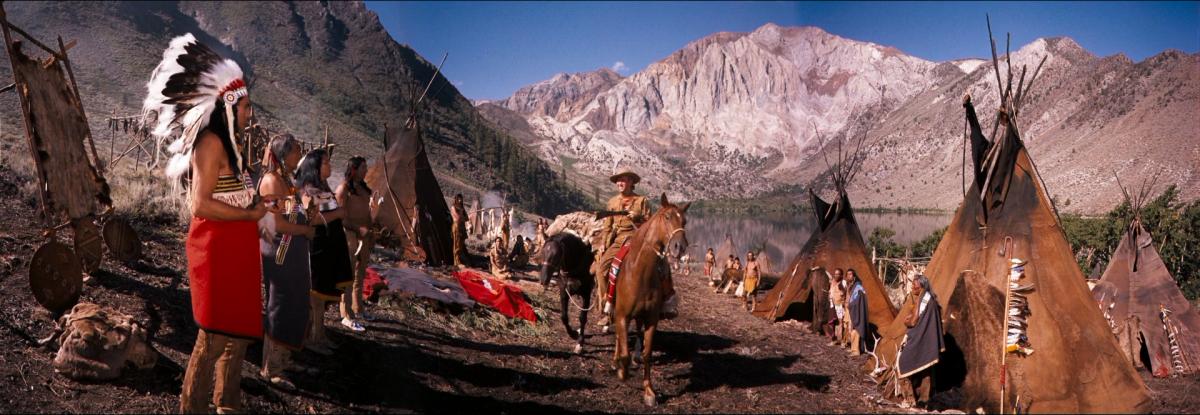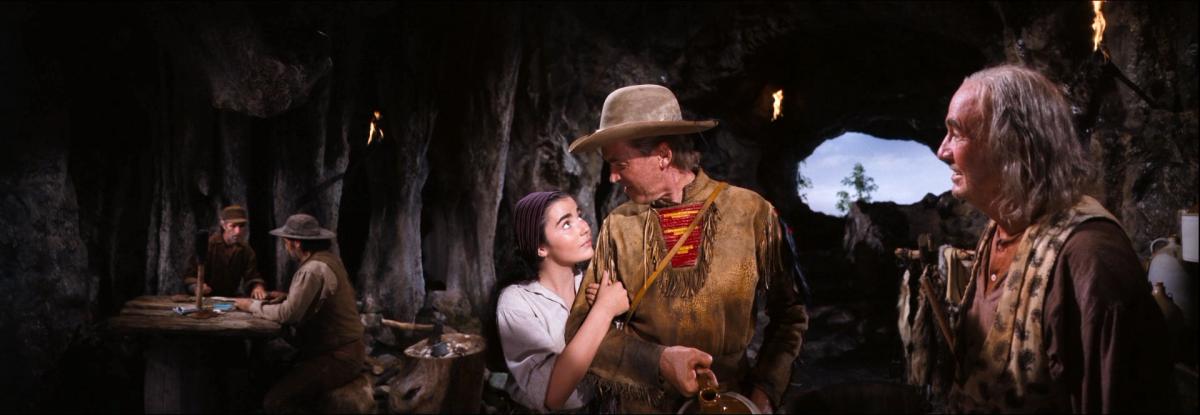The Western
“Cowboys are the last real men left in the world, and they’re about as reliable as jackrabbits.” (The Misfits)

The western used to be the secret garden of male imagination. Access to it has been closed off, the paradise parceled out, its inhabitants dispossessed. Next up are “the men who like technology”, but cowboys like horses, landscapes, showdowns. For this, freedom is the condition, reward and punishment.
Westerns are much less violent than Italo-westerns later led us to believe. If anything, the western is the genre of control, not explosion. It is not the genre of words but of silence, not of action but of the act – at best. That is also why westerns are so cinematic: you don’t have to listen, you just have to watch. This is not a psychological trait of the hero, by the way; it only clarifies his moral fibre, his character. The men here are men of few words. Mitchum, Wayne, Fonda, even Eastwood: they are not very good at talking. You see that the beauty of the emotion that is shown can be matched by the beauty of the emotion that is not shown. Suppression? No, just decency and division of tasks. You see variations on the theme of modesty, variations on obvious issues which should not be expressed tautologically all over again. They are homages to unspoken conventions, the gold standard of a proper life.
The fascination of the public, stars and filmmakers with the genre has to do with the essence of masculinity. The unmasking of that moral fibre as sexism caused the intimate culture of masculinity to implode. After the western, other configurations emerged: the neurotic self-pity of the Actors Studio, the psychotic man-machine. They are first and foremost humourless and therefore one-dimensional. Western heroes are one-dimensional and therefore full of humour.
The western is the only genre that managed to express its growing ambition in a reduction of means. Every megalomaniac western – whether its megalomania concerns the images or the meaning – turned out to be tedious. Only the tension of a form stripped to the bone could give the genre its inner strength. The reduction of the characters was an important part of this.
This tendency towards simplification, this defence against the logic of spectacular accumulation (of effects or meaning) could not find a better place than the western, because the genre could only tackle a great number of technical problems in a pragmatic way. Take the simplicity the landscape itself imposes on the images. In a landscape, crazy camera positions, fast transitions, and bold contrasts look false and laughable right from the start. The image is prescribed by the subject itself here: no artistic interpretation, but sober presentation. Only in a city setting, in an interior, are spatial fantasies possible. Along similar lines, the Baroque requires churches and palaces for spectacular image compositions – which is impossible in a landscape. In any case, a Baroque landscape was unthinkable until the 1970s. The landscape tolerates only the simplest of forms.
The western, too, requires primitive simplicity, solemnity in the unwinding of simple and overly familiar actions. After the disappearance of the burlesque, the western became the only truly primitive film genre. In the culture of the 19th and 20th centuries, this primitiveness was the one quality to be admired: classic and virile. Women – the Trojan horses of civilization – were fled from in the inelegant angularity of a rough, all too direct, efficient form. At their best, westerns have the moral fibre of a painting by Manet or Cézanne. Not its sophisticated refinement, but its brutality.
The western designates a wind direction, not a place. The name contains an indication (yonder) but not a precise location (no “there” or “here”). The name makes clear that movement – determined only by the vector of direction – is crucial. It is a vague, unlocalised indication. The western does not have a place with a centre – no isolated castle, no location of the crime, no home of love or betrayal. The western is an arrow-shaped line. Its rhythm is determined by arrival and departure. The place one leaves tells us more than the place one would like to go, because that place is not there yet. The arrival is not a homecoming, but a rendezvous with the next place of departure. Leaving again is the crucial moment of the story, but also the essence of its space. The villages do not shelter a centre but are ridiculous gatherings of windows and doors along a thoroughfare.
In this cold linearity of the western, only gestures are capable of establishing a centre, and only for the short duration of a mandate, an assignment. The western’s gestus combines the practical handiwork of self-defence with the high calling of the assignment. In this way, the structure of the assignment can devote itself again and again to the trivial and overfamiliar actions of gunmen and drinkers. Central to the space of the western is the gesture, and that gesture is fundamentally part of the landscape, the sanctifying background that does not trivialise gestures into gesticulation, but elevates them to a fundamental act of creation, that of a human order. Of course western heroes end up in saloons, hotels, courtrooms and barbershops. But invariably those interior spaces are as precarious as tents. They are constructions that pretend to be houses. Their space is never closed and protective, but fragile. Behind the prison wall is always a vast field. No house ever opens onto a backyard; it is on the brink of the precipice of the wilderness. Everything is a backdrop, the landscape bulging through it all. Or are you looking at the backlot, the studio setting that has become more mythical than any reality?
A gesture in a landscape is what it is all about. A gesture that must inescapably lead to departure, never to laying a foundation. A gesture that immediately disconnects itself from the order it establishes, taking no possession of it. Order? That is for women, children and the elderly. The hero gives them order, but the order does not nourish him, however much it nourishes others. The establishing gesture must be able to change into the gesture that bids farewell. Thus, the gesture points in a direction, attaches movement to that direction and places this movement in such a way that space can be created. Not space to live in, but to enter. The western is a celebration of gestures, always drawing from the same small reserve, both overly familiar and overdetermined.
The constant re-establishment of the social determinations and implications of the western is a primal topos of film studies. This most “incorrect” of genres has always been resented for its ideology. But things look very different when you shift your attention to its sparing and tight form. You will no longer see the temporary ideology of a specific American society, but the timeless ambition of a culture to create the purest forms possible.
The gaze on the hero of the western is that of the child on the father, the uncle, the big brother. Voracious attention, boundless admiration, gleaming passion. You only realise it much later, when you see your own children looking at you, in that fraction of a second in which you can catch them, before they avert their admiring gaze like a skittish gazelle. This primary homophilia is one of the most enchanting episodes in any man’s history. It is an episode that is repressed, an idolatry that is feared and will later be denied, neutralised and put into perspective in all possible forms and manners.
This admiration applies first of all to every gesture of the father one wants to imitate as the secret of his being. The gesture that points in a direction (of labour, strength or pleasure). A gesture that, against the vast landscape of admiration, is spontaneously experienced as chivalrous. The daily routine imitated and, in doing so, elevated to the secret of the father and the investiture of the son.
That is how the spectators will later regard both the hero of the western and his black shining enemy, who accompanies him like a shadow so as to allow him to be a hero.
The western therefore belongs to the epic mode, what with the same stately rhythm and the same attention to details that are not captured according to a realistic but to an emblematic logic. Like all epics, the western is imbued with an elegiac relationship to what is narrated. The dramas are never about current events, but always mitigated by the sense of a “past”. Not the past – the western is not a historical costume drama – but irreversibility is what is at stake here. The hero never retraces his steps in the story. That too is the logic of epics.
So is the son’s gaze on the father one of admiration that immediately takes on the colour of remembrance. To admire is already to put in the past tense. Hence the wonderful thoughtfulness in this dry, gritty genre in which men do not budge, because they always already belong to the other world, and because they are the product of a boundless admiration that is as deadly as it is re-creative.

For over half a century, Belgian critic Dirk Lauwaert (1944-2013) published essays on film for magazines including Film & Televisie, Kunst & Cultuur, Versus, Andere Sinema and De Witte Raaf. In addition, Lauwaert wrote about fashion, photography, the city and visual art. For Lauwaert, such criticism was never a purely professional affair; it was, first and foremost, a way of documenting how a film or a piece of art personally impacted him as an amateur. Lauwaert’s film criticism is not, as yet, internationally recognised. To provide a first corrective to this, Sabzian will be publishing a series of roughly ten English translations of Lauwaert’s most notable writings on film. This will provide our international audience with an occasion to become acquainted with his work and its singular writings. Lauwaert was an author for whom “watching film and loving film [was] a way to be with the world”. Remaining suspicious of “the power over the concrete, which is indispensable for life,” Lauwaert was someone for whom the act of watching films made up his “whole life.” In this sense, film for Lauwaert turned into the experience of that “essential, sublime distance.” A more extensive English introduction to Lauwaert can be found here.This text first appeared as “De tuin in het Westen” in Daniël Biltereyst en Philippe Meers (eds.), Film/TV/Genre (Ghent: Academia Press, 2004).
This translation was published by courtesy of Reinhilde Weyns and Bart Meuleman.

